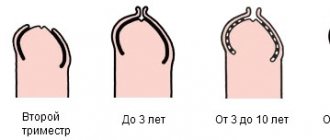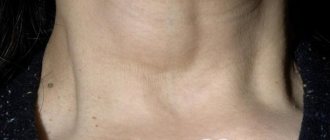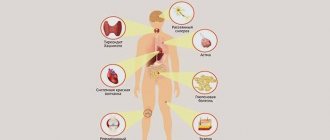Diffuse thyroid goiter
A thyroid goiter is a volumetric increase in thyroid tissue due to its own growth or replacement by new cells.
Thyroid goiter is divided into several types:
- nodular goiter is a collective name that implies palpation or ultrasound determination of an uneven increase in the volume of the thyroid gland of various morphologies (the presence of nodular relief formations with and without a capsule and cavity);
- diffuse goiter can be characterized as a uniform all-round increase in thyroid tissue, which may have hormonal activity (toxicity) and carries with it an aggravation of thyrotoxic abilities;
- Diffuse nodular goiter is an enlarged thyroid gland in all parts with the presence of nodular changes in the stroma of the organ.
Next, diffuse goiter of the thyroid gland will be discussed in detail, what it is, classification, main symptoms and general principles of treatment.
Diffuse goiter of the thyroid gland
Symptoms
A feature of non-toxic diffuse changes is unexpressed symptoms:
- Swelling in the cervical area.
- Increased fatigue, headaches, tightness around the neck, cough, difficulty breathing when lying down.
- Insufficiency of the hormone thyronine, leading to lethargy, dry skin, and bradycardia.
- Difficulty swallowing food.
- Adolescents show signs of disturbances in the functioning of the endocrine system - instability of behavior, psycho-emotional breakdowns. Children are diagnosed with euthyroidism (when the enlarged gland works normally), but speech is impaired, and there is mental and physical underdevelopment.
- In later complicated stages of nontoxic goiter, pathological changes in the heart (dilatation of the right ventricle), hemorrhages in the thyroid tissue, inflammation (strumitis), and the development of malignant tumors are possible.
- Violation of TSH concentration causes an enlargement of the thyroid gland, as a result, strangulation of the trachea and esophagus occurs.
Increased fatigue is a symptom of diffuse non-toxic goiter.
Classification of diffuse goiter
Diffuse goiter of the thyroid gland can be classified by activity:
- hyperthyroid - has thyrotoxic activity, an increase in thyroid hormones is observed;
- euthyroid - hormonal levels do not depend on the size of the thyroid gland;
- hypothyroid - there is an opposite decrease in the concentration of thyroid hormones in response to the proliferation of the latter.
To understand what diffuse goiter of the thyroid gland is, the best way to help is classification, which is based on the features of pathogenesis:
- diffuse endemic goiter;
- Graves-Basedow disease;
- Hashimoto's autoimmune thyroiditis;
- congenital goiter;
- Riedel's fibroplastic goiter.
The most commonly used classification is based on the degree of enlargement of the thyroid gland:
- diffuse goiter of the thyroid gland of the 1st degree - the organ cannot be palpated and is not visible to the naked eye;
- diffuse toxic goiter of the thyroid gland of the 2nd degree - the organ is not visible from the outside, but can be palpated;
- diffuse hyperplasia of the thyroid gland of the 3rd degree - visible from the side and easily palpated.
Symptoms of diffuse nodular toxic
The signs of diffuse nodular toxic goiter are the following manifestations:
- sudden weight loss, despite normal or even increased appetite;
- unbalanced state, tearfulness, irritability and sudden mood swings;
- deterioration of the condition of nails and hair;
- heart rhythm disturbances, which most often manifest themselves as arrhythmia and tachycardia;
- increased sweating and sensitivity to increased room temperature;
- decreased potency in men;
- menstrual cycle disorders in women;
- digestive disorders, diarrhea;
- itching, soreness, swelling and watery eyes.
Reasons for the development of diffuse goiter
As already described, there is a classification based on the characteristics of the pathogenesis of the disease, which is discussed in more detail below.
- Diffuse endemic goiter - occurs in certain territorial areas where there is a tendency for iodine deficiency in foods and the environment. Since triiodothyronine without iodine cannot be converted into an active metabolite, the body does not receive a sufficient amount of the active hormone to carry out the necessary heat exchange. Then the thyroid gland grows compensatory at the expense of parenchymal hormonally active tissue. This pathology usually has euthyroid activity, but is rarely represented by a weak hypertoxic form.
- Graves' disease - this type has a hypertoxic form and is caused by an autoimmune lesion of the thyroid gland. This process can develop after suffering stress, traumatic brain injury (then the main cause is a disorder of the hypothalamus with the activation of an excessive amount of thyroid-stimulating hormone, with which it controls the thyroid gland), and severe viral diseases. Genetic predisposition plays an important role (organ cells have receptors with a foreign protein, as a result of which it is attacked by its own immune factors). As a protective reaction, the thyroid gland begins to divide cells and produce hormones.
- Hashimoto's thyroiditis also has a hereditary predisposition and is caused by an attack of the organ by its own cells. The disease is a chronic inflammation of the gland, where in response to attack the cells die and are replaced by fibrous connective tissue. Hashimoto's goiter has hypothyroid activity.
- Diffuse sporadic goiter in newborns is explained by a lack of iodine in the mother during pregnancy and has similar manifestations as diffuse endemic goiter.
- Riedel's goiter is a fairly rare disease when, after an attack by lymphocyte cells against the background of autoimmune processes, dead parenchyma cells are replaced by fibrin fibers. This enlarged gland becomes very hard, which is why it is popularly called “iron goiter.”
Causes
The most common cause of the development of pathology is a hereditary factor.
If this thyroid disease was present in one of the parents or other close relatives, then the risk of developing it in the younger generation increases several times.
Additional reasons:
- lack or excess of iodine in the body;
- chronic autoimmune diseases (rheumatoid arthritis, scleroderma, etc.);
- hormonal changes in the body;
- stress and nervous tension.
Diffuse goiter can develop after surgery to remove a cyst or tumor of the thyroid gland. The reasons are also often associated with increased levels of radiation in the place of residence.
Clinical manifestations of diffuse thyroid gland
Diffuse thyroid goiter has specific and nonspecific symptoms. Nonspecific clinical manifestations will not depend on hormonal activity and will include:
- pain in the thyroid gland;
- increased fatigue and feeling of weakness;
- a feeling of tightness in the neck;
- sore throat, sometimes dry cough for no reason;
- the appearance of shortness of breath when lying down or turning the head.
If the goiter has euthyroid activity, then the above-described clinic will not add anything else.
Diffuse goiter of the thyroid gland also adds specific symptoms for hyperthyroidism:
- hyperthermia;
- increased sweating;
- excessive irritability;
- disorders of sexual activity in both sexes;
- tachycardia;
- increased blood pressure numbers;
- weight loss and negative nitrogen metabolism;
- shine in the eyes, bulging of the eyeballs, photophobia;
- tremor of fingers;
- thinning of the skin and appendages (increased fragility of nails and hair loss and thinning);
- increased appetite and tendency to diarrhea.
Diffuse goiter with hypothyroid activity also has a number of specific signs:
- obesity;
- hair loss;
- dry and greasy skin;
- slowness;
- tearfulness;
- tendency to constipation and flatulence;
- increased swelling;
- impaired libido in men and menstrual function in women;
- depression;
- bradycardia;
- sleep inversion (drowsiness during the day, insomnia at night).
Clinical picture
As a result of the fact that the function of the organ is not impaired in this disease, the clinical picture is very poor.
Symptoms of diffuse non-toxic goiter:
- Asthenoneurotic syndrome: weakness, drowsiness, increased fatigue, decreased performance.
- Periodic headaches.
- When a goiter appears to a large size, internal organs are compressed. Compression of the esophagus leads to impaired swallowing. Due to compression of the trachea, there may be a feeling of a lump in the throat and breathing problems in the form of shortness of breath. As the goiter grows and it compresses the trachea, shortness of breath increases and occurs at rest, as well as when changing body position. With continued growth and untreated, shortness of breath can lead to suffocation. Compression of blood vessels leads to the development of superior vena cava syndrome.
- Changes in the contour of the neck as a result of an enlarged goiter.
- May be complicated by: strumitis, thyroiditis, hemorrhage, development of a toxic form.
Diagnosis of diffuse non-toxic goiter
- It begins with identifying an enlarged gland by palpation. If the proportion of more than one distal phalanx of the thumb of the patient being examined, one should speak of the presence of a goiter.
- The most informative laboratory indicators for the non-toxic form are the hormones TSH, T3, T4, as well as the prohormone of the thyroid gland - thyroglobulin.
- Ultrasound examination allows you to find out the exact volume of the thyroid gland, its structure, the presence or absence of nodes. If an increase in the volume of the gland is detected in men by more than 25 ml, and in women by more than 18 ml, a diagnosis is made - diffuse non-toxic goiter.
- If nodules are suspected or found during sonography, a puncture biopsy is recommended. This diagnostic method allows you to accurately determine the cellular composition of the node. Fine-needle biopsy is most often performed to identify thyroid tumors.
- Scintigraphy is a method that allows you to assess the uniformity of isotope distribution in the gland and identify the number and size of nodules.
- To confirm compression of the esophagus, contrast radiography is performed.
Diagnostic stages of pathology detection
First of all, you need to know that diffuse goiter of the thyroid gland - symptoms and treatment can only be most accurately determined by an endocrinologist.
Suspicion of pathology begins with collecting a medical history, life history and an objective examination.
The main important integral part in the examination for this pathology is palpation.
After the doctor makes a preliminary diagnosis, the disease must be confirmed laboratory and instrumental.
To do this, the following research methods are used:
- ultrasound examination of the thyroid gland;
- laboratory blood test for the concentration of T3, T4, TSH, antibodies to TSH receptors;
- plain radiography of the thyroid gland;
- computed tomography using contrast agents;
- scintigraphy;
- fine-needle percutaneous aspiration biopsy.
Laboratory tests and scintigraphy results will depend on the degree and type of hormonal activity, which will help us establish it and understand how to treat diffuse thyroid goiter.
When other methods are aimed at establishing the size, structure and causes of an enlarged thyroid gland.
Diagnostics
The following methods are used to diagnose this thyroid disease:
- Blood analysis. Helps determine the level of thyroid-stimulating hormone. Exceeding this indicator gives reason to suspect the presence of diffuse goiter.
- Ultrasound. Using ultrasound diagnostics, you can determine the condition of the thyroid gland, identify deviations in the size of the organ from the norm and determine the degree of its damage. In addition, ultrasound examination can detect a tumor in the gland.
- Linked immunosorbent assay. Necessary for identifying abnormalities in the functioning of the body's immune system. Based on the results of this analysis, it is possible to determine whether antibodies to TSH and thyroglobulin are being produced.
If the size of the organ exceeds the permissible values, and the doctor has doubts, a biopsy is performed with further examination of the material for the presence of atypical cells.
Therapeutic measures
After identifying the cause, and when diffuse enlargement of the thyroid gland is fully diagnosed, treatment is selected individually by the attending physician.
Therapy is divided into drug and surgical.
Conservative therapy
Drug treatment is aimed at normalizing the hormonal activity of the enlarged organ, and subsequently at its physiological reduction.
With the development of endemic goiter, it is necessary to take iodine-containing drugs (Iodomarin 200, potassium iodide, diiodotyrosine), since one dose of these drugs can solve the problem and completely cure the disease.
Thyreostatic drugs (Mercazolil, Propylthiouracil) are used to suppress excessive production of triiodothyronine in thyrotoxicosis and are a necessary preparation for surgery for Hashimoto's thyroiditis and other autoimmune hypothyroidism.
Thyroid hormones (L-thyroxine) - used as replacement therapy for insufficient production of thyroid hormones, while taking thyreostatics, after removal of the thyroid gland.
As a symptomatic treatment of pathological processes caused by interruptions in the functioning of the gland, B-blockers are used (to normalize the heart rhythm, lower blood pressure), sedatives, and glucocorticosteroids.
Surgery
The need for surgical intervention may be due to:
- ineffectiveness of conservative therapy for six months;
- grade 3 goiter or severe thyrotoxicosis;
- allergic reaction to thyreostatics;
- complication in the form of atrial fibrillation.
Surgery may be limited to resection of the thyroid gland (part of the gland) or thyroidectomy (entirely), which will depend on the degree of activity and size of the organ.
Treatment
Diffuse goiter is a disease that requires complex treatment. Drug therapy is basic. Mercazolil is considered the most effective drug in treating the disease. This medication inhibits the production of thyroid-stimulating hormones, helping to normalize the patient's condition.
Beta-blockers and sedatives are used as adjuvant therapy. Taking vitamins B, C and A plays an important role.
For diffuse goiter, calcium supplements are used. However, it is necessary to monitor kidney function by periodically performing a urine test.
Surgical intervention is indicated only for severe enlargement of the thyroid gland.
Surgical intervention is indicated only in case of severe enlargement of the thyroid gland, as well as if the patient has been identified as individual intolerant to Mercazolil.
Compliance with a special diet plays a special role. Chocolate, coffee and spicy seasonings are excluded from the diet, and the consumption of plant fiber is increased.
Methods of treatment with folk remedies
Traditional methods of treatment can only be used as an auxiliary therapy. The most popular and effective way is to eat a decoction of walnut partitions. To prepare it, 200 g of raw material is poured into 500 ml of water and boiled for 5 minutes. After the broth has cooled, filter it through a fine sieve. The resulting drink should be taken on an empty stomach.
Oregano also works well for this thyroid pathology. To do this, dry grass in the amount of 2 tsp. you need to pour 400 ml of boiling water and let it brew for 10 minutes. A drink based on oregano helps slow down the activity of thyroid-stimulating hormones. You can drink it instead of tea.
To normalize TSH production, you can use sage. 2 tbsp. l. pour 500 ml of boiling water over the sage and let it brew for 15 minutes. Add sugar to taste. You can drink this drink 2 times a day as tea.
Symptoms
What are the symptoms of nodular toxic goiter? Let's look further.
Since thyroid hormones are responsible for performing various physiological functions, the appearance of thyrotoxicosis is accompanied by a variety of clinical manifestations. Typically, patient complaints are directly related to cardiac and vascular changes, with symptoms of endocrine ophthalmopathy and catabolic syndrome. Cardiac and vascular disorders can be manifested by rapid, pronounced heartbeat, that is, tachycardia. Patients may feel palpitations in the chest, abdomen, or arms. Heart beats at rest in the presence of thyrotoxicosis can increase to 130 per minute. In the presence of moderate severity of thyrotoxicosis, an increase in systolic and a decrease in diastolic pressure is observed, along with an increase in pulsation.
Causes of the disease
The exact causes that cause nodular toxic goiter have not yet been established by medicine. There is one theory according to which a mutation occurs in the genes that carry information about the production of hormones in the body. This leads to the fact that in the structure of the epithelium of the thyroid gland, cells that independently secrete thyroid hormones, that is, thyroid hormones, begin to be actively produced.
According to another assumption of scientists, mutational disorders occur not in genes, but in G-proteins. This is a specific class of proteins that are responsible for the activation of intracellular processes. A disruption in the functioning of these proteins provokes the appearance in the thyroid gland of cells that have functional independence in the secretion of thyroid hormones. Such independence is understood as a condition in which thyroid hormones are produced chaotically, disproportionate to the needs of the body.
Under normal conditions, the amount of thyroid hormones in the blood depends on the pituitary gland - in particular, on thyroid-stimulating hormone. The higher its level, the more hormones T3 and T4 are produced. But since in nodular toxic goiter the receptor endings of cells for thyroid-stimulating hormone in the thyroid gland work abnormally, they give a constant signal about the need to increase the level of production of thyroid hormones, which is what the cells of the autonomous nodes do. This occurs regardless of whether the receptor has bound to TSH and whether there is a signal about its quantity or not.
In addition to the direct factors causing hypersecretion of thyroid hormones, there are a number of factors that influence the development of nodular toxic goiter. They can become its trigger. Among the main causes of this disease, the following are most often identified:
- constant stress;
- chronic exposure to low ambient temperatures on the body;
- smoking tobacco and alcohol abuse, taking toxic substances;
- genetic predisposition;
- disruption of adaptation mechanisms when a person’s living conditions change (sudden change of climate or time zone);
- radioactive radiation.
Causes and signs of the disease
Hormonal imbalance during pregnancy, breastfeeding, menstruation or menopause contributes to the development of the disease. Among the main reasons provocateurs are:
- traumatic brain injuries;
- mental disorders;
- genetic predisposition;
- bad ecology;
- autoimmune response of the body;
- unfavorable habitat;
- viral infections.
The main cause of diffuse toxic goiter is considered to be a dysfunction of the immune system. Symptoms of the pathology or the classic clinical picture are bulging eyes, goiter and palpitations. On the part of organs and systems important for normal functioning, signs of pathology appear:
- accelerated metabolism;
- intolerance to hot weather;
- excellent appetite, but at the same time there is a sharp weight loss;
- diarrhea;
- malaise;
- tremor of the body and limbs;
- rapid fatigue;
- general weakness;
- insomnia;
- swelling of the body;
- arrhythmia;
- heart failure;
- tachycardia;
- enlarged abdomen;
- hyperactivity of motor reflexes;
- increased temperature;
- candidiasis in the oral cavity;
- increased sweating;
- brittle nails.
In males, erectile dysfunction and enlarged mammary glands are observed. Symptoms of diffuse toxic goiter in women are infertility, menstrual irregularities and severe pain in the lower abdomen, fibrocystic mastopathy. On the part of the organs of vision, an increase in intraocular pressure, conjunctivitis, a feeling of sand in the eyes, incomplete closure of the eyelids, rare blinking, and lag of the lower eyelid from the eyeball are observed.
Diffuse toxic goiter: clinical recommendations
This is a special document that is issued at regular intervals and is designed for practicing doctors. Clinical guidelines contain the most up-to-date information proven in practice on the following issues:
- diagnostics;
- treatment;
- rehabilitation;
- prevention.
This document defines an algorithm of actions for patient management. The doctor is given the right to choose diagnostic and treatment methods depending on the individual characteristics of the individual, his gender, age, and the course of the pathology. Currently, the methods of therapy described in clinical recommendations are used in practical medicine. Diffuse toxic goiter is recommended to be treated using three methods:
- conservative;
- surgical;
- radioactive iodine.
For each type, the level of evidence is given and comments are provided, which outline detailed treatment regimens and necessary examinations. In addition, side effects and complications that occur during therapy are described. The document contains a special section that specifies mandatory requirements for the doctor; their fulfillment affects the outcome of the disease, in particular diffuse toxic goiter.
Therapy during pregnancy
If a pregnant patient has toxic diffuse goiter, she should be under regular supervision not only by a gynecologist, but also by an endocrinologist. Treatment of this disease during pregnancy is carried out with Propylthiouracil (this drug does not pass well through the placenta) in the minimum dosage necessary to maintain the amount of thyroxine. As the duration of pregnancy increases, the patient's need for thyreostatics decreases, and most women no longer take this medication after the thirtieth week of pregnancy. After childbirth, they usually develop relapses of thyrotoxicosis.
Treatment for nodular toxic goiter of thyrotoxic crisis involves intensive intake of large dosages of thyreostatics. Preference is given to "Propylthiouracil". If it is impossible for the patient to self-administer the drug, it is administered through a nasogastric tube. Additionally, glucocorticoids are prescribed in combination with adrenergic blockers, therapy, plasmapheresis, and so on.
Is it possible to cure diffusely toxic goiter?
The prognosis in the absence of treatment is extremely unfavorable. The patient develops serious complications and the disease progresses. If the thyroid gland normalizes, the prognosis is good. In the case of surgical treatment of the disease, there is a high probability of the formation of hypothyroidism, in which metabolic processes in the individual’s body slow down. The reason for this phenomenon lies in the insufficient production of hormonal substances (triiodothyronine and thyroxine). Patients are advised to exclude foods and medications containing high concentrations of iodine, and also to minimize the duration of exposure to direct sunlight.
Preventive measures include:
- Maintaining and strengthening the immune system, which involves hardening, regular walking, and performing gymnastic exercises.
- Compliance with diet. Include in your diet foods that contain animal and plant protein, raw vegetables and fruits.
- Elimination of stress, as it plays a dominant role in the development of pathology. In some cases, the doctor may recommend taking herbal sedatives.
- Timely treatment of viral infections.
There is no specific prevention of diffuse toxic goiter. To prevent pathology, dispensary observation by an endocrinologist in a clinic at the place of residence is indicated.
Classification of the disease
In general, diffuse goiter is divided into several types:
- Diffuse non-toxic goiter - occurs due to disruption of the thyroid gland, not associated with inflammation or tumor. occurs due to unfavorable environmental conditions and genetic disorders. Typically, with such a goiter, the thyroid gland protrudes outward at the front of the trachea.
- Colloidal nodular goiter - also called endemic, occurs due to iodine deficiency. It occurs more often in women after forty years of age, when living in an area with insufficient iodine.
- A simple non-toxic goiter - can be spherical or diffuse; it is hypertrophy of the thyroid gland without an inflammatory process, hypo- or hyperthyroidism. This is a non-cancerous form of thyroid changes. Usually occurs during the period of hormonal changes in the body (pregnancy, puberty).
- Nodular nontoxic goiter - nodules appear on the surface of the thyroid gland, which can only be seen with a scan. The causes of nodular goiter are unknown. It could be a genetic disorder or an unhealthy diet.
Depending on how strongly non-toxic diffuse goiter is expressed, the following types are distinguished:
- 0 degree – the gland cannot be palpated;
- 1st degree – only the isthmus is palpable;
- 2nd degree – an increase is visible when swallowing;
- 3rd degree – completely palpable;
- 4th degree – the appearance of the neck changes;
- Grade 5 – very large sizes.
We recommend you find out: How are a painful thyroid gland and hair loss related?
Of course, with grades 0 and 1, the problem is almost impossible to determine, since such a change is not visually visible and other symptoms may not appear.
And the next degrees are more pronounced, so they are easier to diagnose. Therefore, grade 1 goiter is most often detected only during routine checks.
Stages of disease development
Diffuse nontoxic goiter in most cases develops slowly. In modern medicine, it is customary to distinguish three stages, guided by external signs:
- At the so-called zero stage, there are no visual changes - the contours of the neck remain the same, and even upon palpation it is difficult to determine the presence of the disease.
- Diffuse non-toxic goiter of the 1st degree cannot be determined upon examination, but during palpation an experienced doctor can note an enlargement of the gland.
- At the second stage of development, the goiter can not only be felt with your fingers, but also seen - the enlarged thyroid gland is visualized as a large lump under the skin.
This classification scheme has important diagnostic value.
Skin changes
In the presence of this pathology, the skin is usually soft and warm to the touch, and in some patients vitiligo occurs, the folds of the skin darken, especially on the elbows. In 5% of patients with this pathology, pretibial myxedema develops, which is expressed in swelling, thickening and erythema of the skin in the area of the lower leg and feet.
In the presence of diffuse toxic goiter, a uniform enlargement of the thyroid gland is noted. Sometimes the gland is significantly enlarged, and sometimes the goiter may even be absent (this happens in 25% of cases). The severity of the pathology is not determined by the size of the goiter, since with a small volume a severe form of thyrotoxicosis can also occur.
Now let's move on to consider the methods of treating this disease and find out how it is eliminated in the conditions of modern medicine.
Myocardial dystrophy
In case of prolonged course of thyrotoxicosis, especially in elderly patients, bright and pronounced myocardial dystrophy develops. It can manifest itself as disturbances in the heart rhythm, which will be expressed by atrial fibrillation and extrasystole. Subsequently, all this will lead to changes in the myocardium and to congestion. For example, peripheral edema, ascites and cardiosclerosis may appear. There may be respiratory arrhythmia, as well as a tendency to frequent pneumonia.
The occurrence of catabolic syndrome is characterized by a sharp weight loss of about 15 kilograms against the background of a good appetite. General weakness and hyperhidrosis cannot be ruled out. Violation of thermoregulation, as a rule, manifests itself in the fact that the patient experiences a feeling of heat and does not freeze at sufficiently low ambient temperatures. Elderly patients may experience low-grade fever in the evening.











